While the basis of composting is always using rotted organic waste as a fertilizer, the techniques can vary significantly.
With a plethora of modern and traditional composting methods from which to choose, there will be a way to compost that suits you. One of the many systems you will stumble upon when investigating composting methods is trench composting, also known as in-ground composting.
This article will tell you a bit more about trench composting, including what it is, different trench composting methods, and how it stacks up against traditional composting.
What is Trench Composting
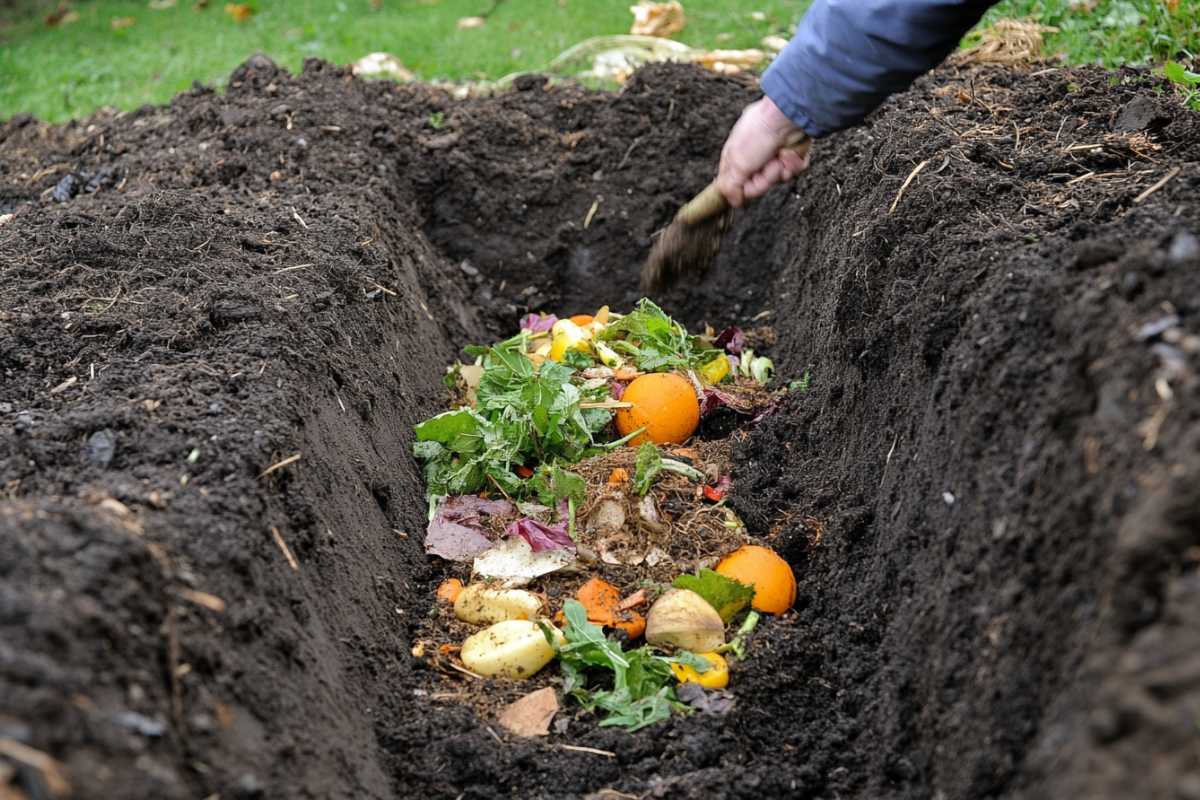
The trench composting method’s process is just as it’s named. You dig a trench in the ground to put your composting materials in.
It decomposes the waste in pretty much the same way as a regular compost pile, except you can leave the compost underground in the original place where it was buried. There is no need to turn it.
To start trench composting, dig a trench in your garden. Add a layer of food scraps and garden waste to the channel, and sprinkle a layer of soil over the top of each layer.
When the trench row is filled, you can dig another composting trench and start over. Fill each row with compostable materials, just like you would with a traditional compost pile.
As the composting material decomposes, the nutrients will start to spread through the soil to the nearby plants in the garden bed.
Benefits of Trench Composting
There are many advantages to trench composting, a form of in-ground composting. Here are the top benefits that you reap from trench composting:
1. Low Maintenance Composting Method
Trench composting is probably one of the most low-maintenance methods of composting. Your only work will be digging the initial trench. There is no need to remove the compost or turn the pile, unlike traditional compost heaps.
Trench composting is a cold composting method, and you won’t need to worry about pH levels or if your heap is at the wrong temperature. You only need to fill the trench with organic materials and dirt, then leave it to do its thing.
As you’ll be filling your trench with the soil you dug out, you won’t need to worry about the green to brown ratio either. The dirt you put back in to fill the trench will absorb moisture from the green material and add it to any brown materials.
2. Cost-Effective Composting
You won’t need to construct anything to start trench composting, and you won’t have to buy any materials, including a compost bin or tumbler.
You will only need a spade and some initial effort to dig the trench.
3. Great for Growing Vegetables
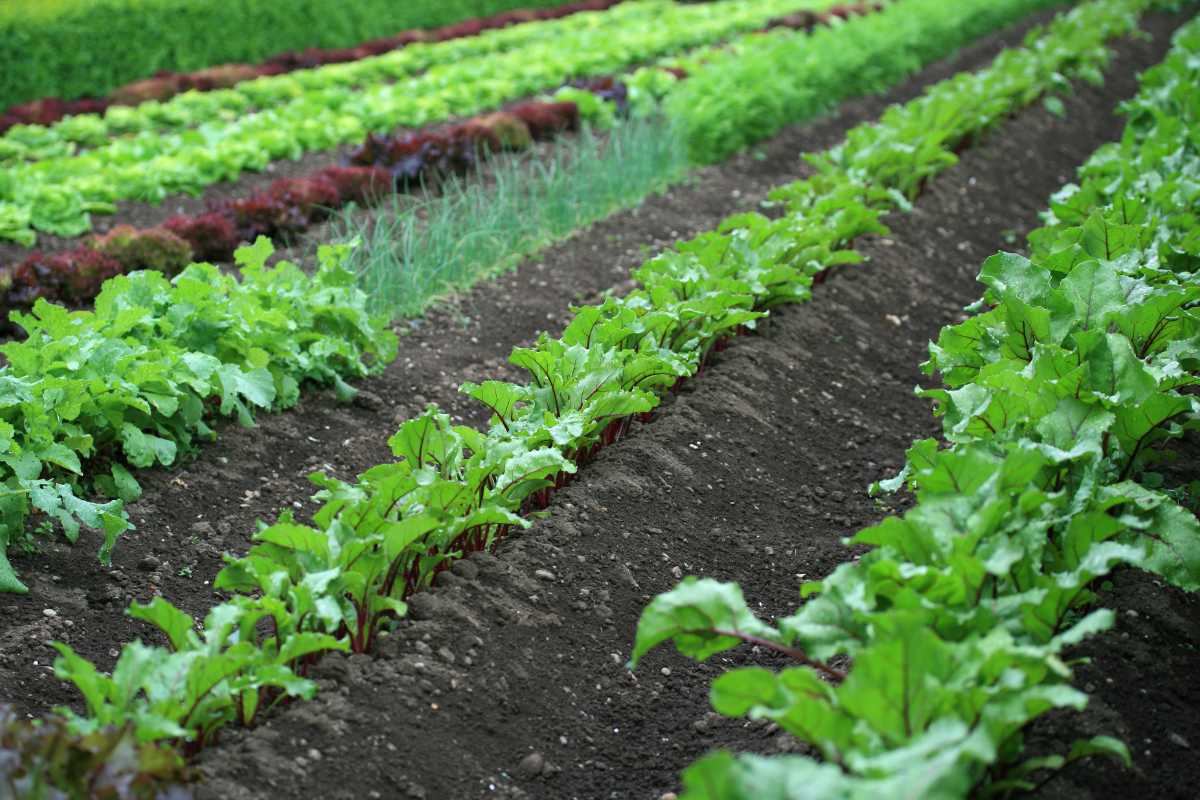
If you have a vegetable plot, I recommend this method of composting.
I will cover more information about how you can use trench composting in your vegetable garden.
4. Your Soil Structure Will Be Improved
In traditional composting, compost is only dug into the top six to twelve inches of soil.
In comparison, you should make your trench around eighteen to twenty inches deep. These deep holes add compost and its nutrients to the deeper layers of soil.
As the compost will form deep in the ground, trench composting can greatly improve your soil structure when the compost materials have decomposed.
5. It Attracts Worms to the Soil.
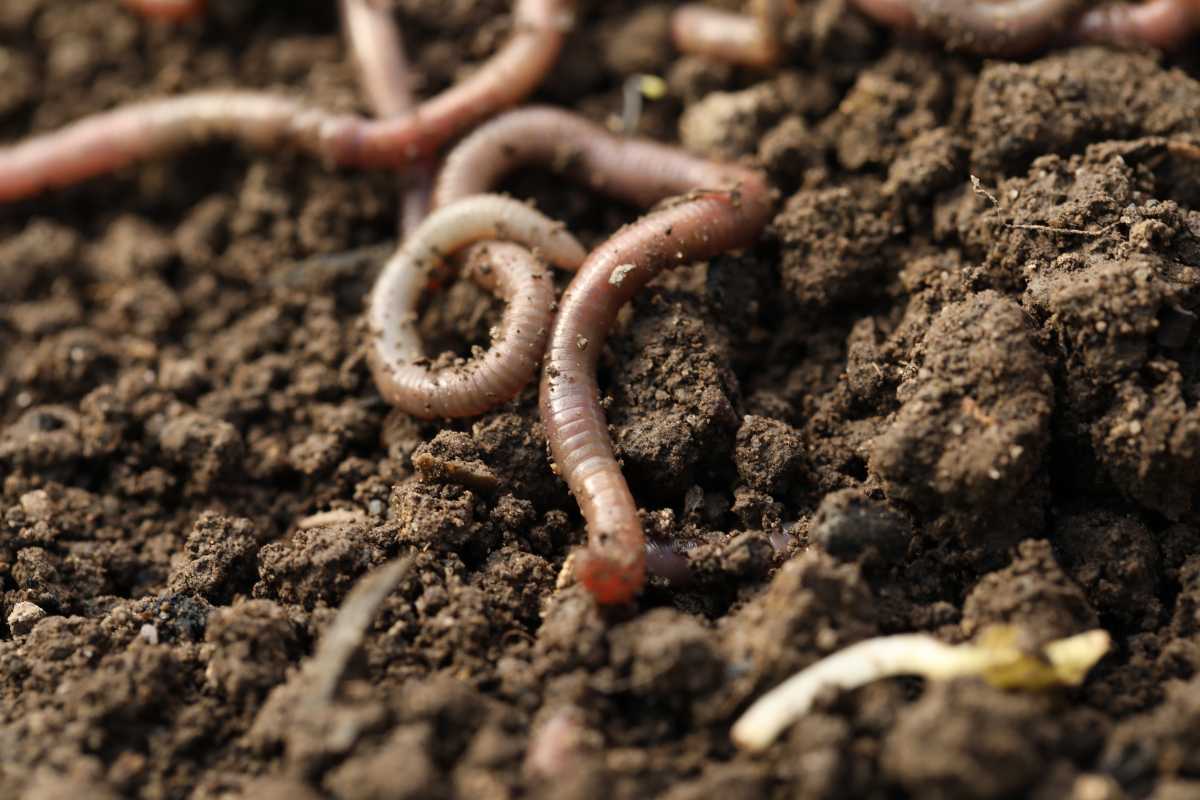
Worms help break down the organic matter and aerate the soil in your garden, making them a valuable asset when gardening.
Using the trench composting method, you won’t be dividing your worms between the compost heap and your soil, so you can reap the maximum benefit from these wonderful invertebrates.
Worms especially help turn food waste, landscape waste and other organic waste into the highly sought “black gold” finished compost that all gardeners are after.
6. Great if You Want to Plant a Hedge.
If you plan to plant a hedge, dig the trench about three to six months before planting.
Compost in the channel as described, and when you plant your hedge, you will have enriched the soil so your chosen shrubs will have plenty of nutrients and loose soil that’s ideal for root growth.
Three Trench Composting Methods
There are three different ways to compost in trenches, each with their own advantages.
1. Trench Rotation
Trench rotation is just like crop rotation and can be used in conjunction with a crop rotation system.
Each year, use one area of your garden for your trench compost pile. You can then plant heavy feeders like tomatoes or squash in this area the following year, and you won’t need additional fertilizer.
Continue to dig a trench composting hole in a new location until you have composted your entire garden, at which point you can start again.
2. Trenching Between Rows
You can dig a compost trench between your rows of plants/vegetables or down the center of the garden borders. This placement will add nutrients to your soil immediately.
Add hot green materials, such as fresh chicken manure, fruit and vegetable scraps, and grass clippings.
Once you have added your layer of mud, these hot greens will decompose rapidly, feeding your vegetables as they grow.
3. Dig and Drop
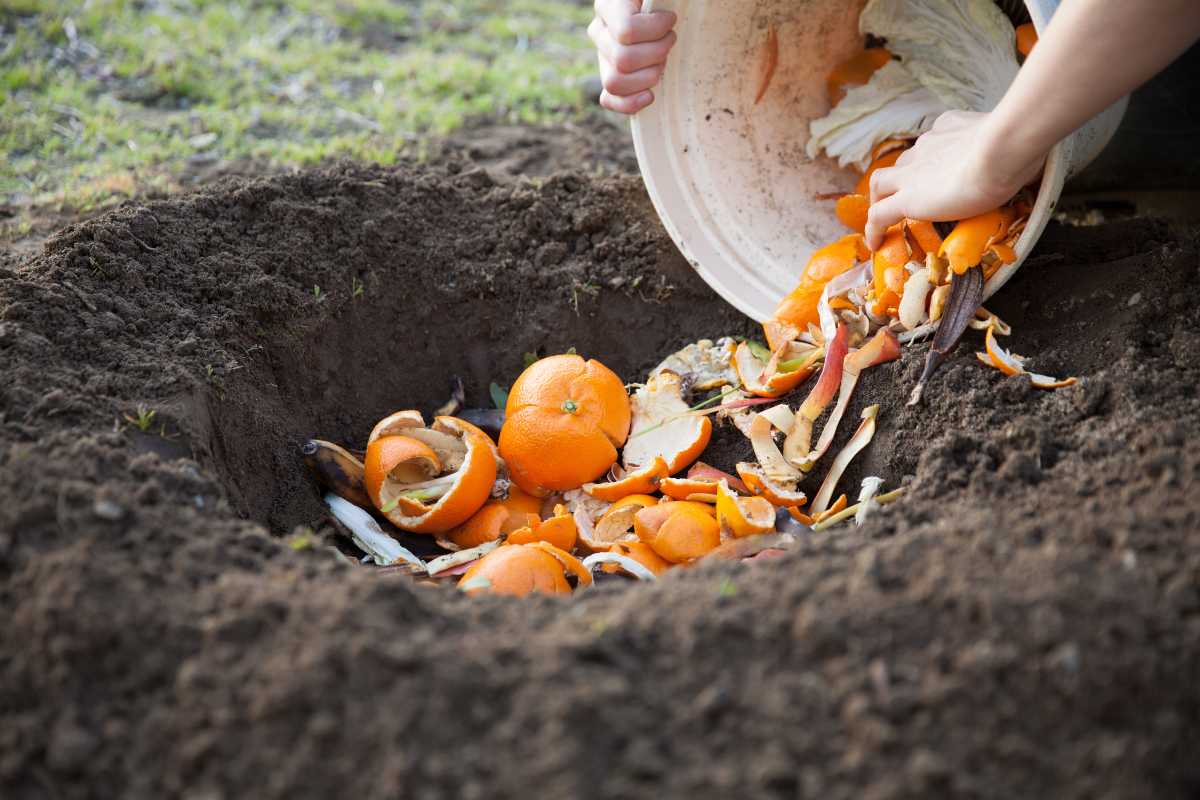
With this method, you don’t even need to dig a long trench. Simply dig a compost hole every time you have something to compost, drop in the organic matter, and fill in the hole again.
You need to keep track of where you are digging your spots with this system to ensure you don’t disturb the decomposition process by digging in the same place too soon. Also, you will need more room with this method than with the previous two.
How to Trench Compost
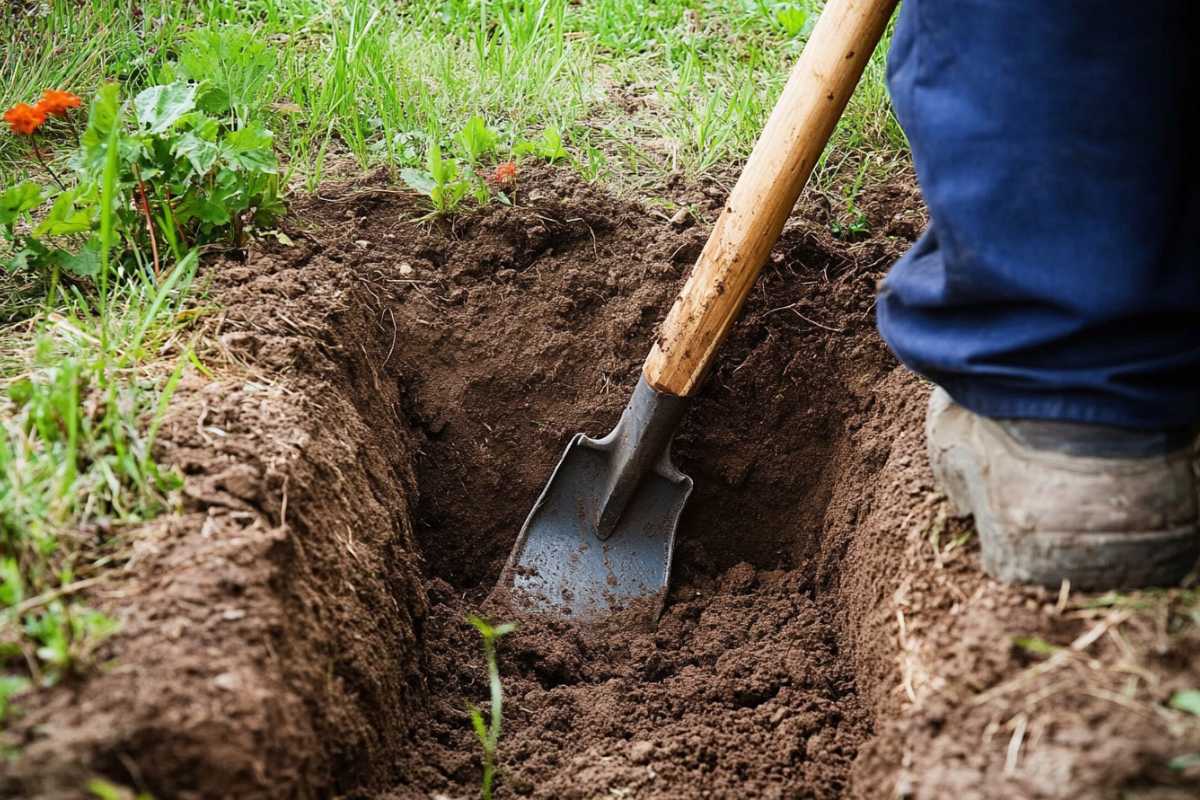
Trench composting is sometimes called the lazy gardener’s method, and it certainly lives up to its reputation (after the initial digging).
The only essential equipment for this type of composting is a spade. You might want a kitchen compost bucket to collect your kitchen scraps while inside the house. This way, you won’t have to trek out to your trench every time you peel an orange or need to dump your daily coffee grounds.
If you want to invest more money than time, you can also use a chipper shredder to shred up any bulky materials like branches or cardboard, but this depends on what you’ll be adding to your trench.
I find that the best way to do trench compost is in conjunction with crop rotation.
- Leave one area fallow when planting your vegetables and use this area for your trenches.
- Dig the first trench and store the soil, or spread it over your garden.
- As you fill the first trench with organic materials, start your second trench by adding a spade-full of dirt each time you add some organic material.
This process will help spread the work of digging your subsequent trenches, as once your first trench is filled, your second trench will have been dug already.
Trench Composting Step-by-Step
Here are the steps to trench composting:
Step 1 – Choose the Site for Your Trench
Remember, this is just the first trench, so plan where you will put the following ones once the first one is filled. Good sites for channels include borders and vegetable patches.
Step 2 – Dig the Trench
Your trench should be at least 12 inches deep, but ideally it will be 18-20 inches. How wide and long your trench should be depends on your situation.
Step 3 – Start Adding Your Organic Materials
These can be food scraps, tea leaves, coffee grinds, garden waste, paper, and cardboard. Some people add matter like dairy products and meat, as because you are burying it, the issues with scavengers will be limited.
Personally, I still don’t use cooked foods, meat, or dairy in a trench, as animals can (and will!) dig up the scraps and cause a mess of your garden.
Step 4 – Fill in the Trench
Every time you add a layer of organic materials, add a layer of dirt. This technique will help the decomposition process and enrich your soil.
Step 5 – Once Your Trench is Full, Start Again
Some people prefer lots of shallow trenches that are quick to fill, and others like to dig one deep trench and take their time filling it. This choice is just a personal preference and depends on your requirements.
Trench Composting vs. Traditional Composting
Above ground, pile composting differs from trench composting in many ways. There are disadvantages and advantages to both, and which you choose will depend on your needs.
I’ve listed many of the pros of trench compared to traditional composting above, like its low-maintenance and cost-effectiveness. Let’s take a look at the cons of trench, underground compost here.
You will need more space for trench composting. Most modern and traditional composters require a dedicated area for composting that you don’t need to move.
But you need to dig a fresh trench once you’ve filled in the old one with the trench method. While this is fine for growing annual plants, it is not ideal if you have a small-scale yard with a lawn or perennials.
You won’t be able to use your compost for anything else. With trench composting, you won’t need to move your compost to use it. However, as it is in the ground, you won’t be able to use it for mulch, compost tea, potting mixes, or greenhouses. In this context, traditional composting is definitely more versatile.
Trench Composting Final Thoughts
Hopefully, this article has given you some insight into whether trench composting is suitable for you.
If you feel that trench composting is not appropriate for your situation, check out my other article, Different Types of Composting Methods, to see if there is another way of composting that might suit you better.
Other great composting articles to learn more:
Trench Composting FAQs
Does trench composting attract rats?
Yes, trench composting can attract rats, but not it’s less than traditional composting piles above ground. Rats love rotting organic matter and will eat anything from spoiled fruit to dead animals. Stay away from adding dairy and meat to your compost as they can produce smells for rats. Trench composting is a great way to reduce the risk of rats, pests, and other rodents to your compost because it’s dug deeper underground.
Does trench composting attract worms?
Trench composting attracts worms because it creates a moist environment where they can live and feed. Worms love moist environments, so it’s an ideal environment for worms. Trenches are dug into the ground where they can burrow into the soil. Composting organic waste in trenches can be easier than maintaining traditional compost piles.
Does trench composting attract ants?
Yes, trench composting can attract ants, but it’s rare and unlikely, especially when compared to regular compost bins. Ants and other insects are attracted to decomposing organic matter, but because trench composting buries the waste 12-20 inches below ground to decompose. This will help protect the decomposing compost materials from ants.

